ECU CITROEN C-CROSSER DAG 2012 Handbook (in English)
[x] Cancel search | Manufacturer: CITROEN, Model Year: 2012, Model line: C-CROSSER DAG, Model: CITROEN C-CROSSER DAG 2012Pages: 244, PDF Size: 7.49 MB
Page 100 of 244

V
!
CHILD SAFETY
98
The incorrect installation of a
child seat in a vehicle compro-
mises the child's protection in
the event of an accident.
For information regarding the ISOFIX
child seats which can be installed in
your vehicle, refer to the table show-
ing the locations for ISOFIX child
seats.
"ISOFIX" mountings
These are three rings for each seat:
- two rings A
, located between the
vehicle seat back and cushion, indi-
cated by a label,
- a ring B
, used to fi x the upper strap,
referred to as the TOP TETHER
, in-
dicated by a label. This ISOFIX mounting system provides
fast, reliable and safe fi tting of the child
seat in your vehicle.
The ISOFIX child seats
are fi tted with
two latches which are secured easily on
the two rings A
.
Some also have an upper strap
which
is attached to the ring B
.
To attach this strap, remove the vehicle
seat's head restraint. Then fi x the hook
on the ring B
and tighten the upper
strap. Your vehicle has been approved in accor-
dance with the new
ISOFIX regulation
.
The seats, represented below, are fi tted
with regulation ISOFIX mountings:
Page 101 of 244
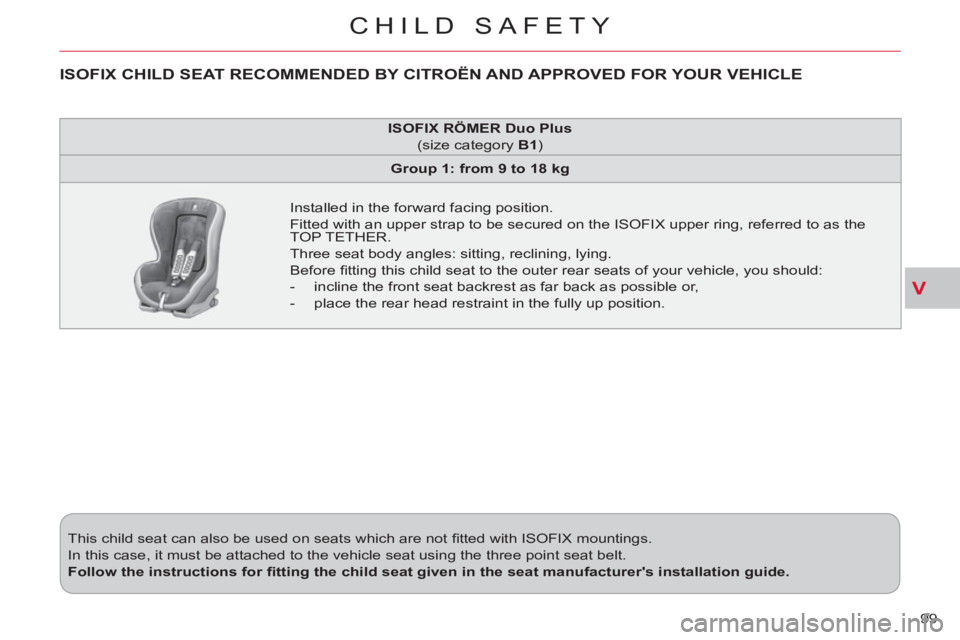
V
CHILD SAFETY
99 This child seat can also be used on seats which are not fi tted with ISOFIX mountings.
In this case, it must be attached to the vehicle seat using the three point seat belt.
Follow the instructions for fi tting the child seat given in the seat manufacturer's installation guide.
ISOFIX
RÖMER Duo Plus
(size category B1
)
Group 1: from 9 to 18 kg
Installed in the forward facing position.
Fitted with an upper strap to be secured on the ISOFIX upper ring, referred to as the
TOP TETHER.
Three seat body angles: sitting, reclining, lying.
Before fi tting this child seat to the outer rear seats of your vehicle, you should:
- incline the front seat backrest as far back as possible or,
- place the rear head restraint in the fully up position.
ISOFIX CHILD SEAT RECOMMENDED BY CITROËN AND APPROVED FOR YOUR VEHICLE
Page 102 of 244
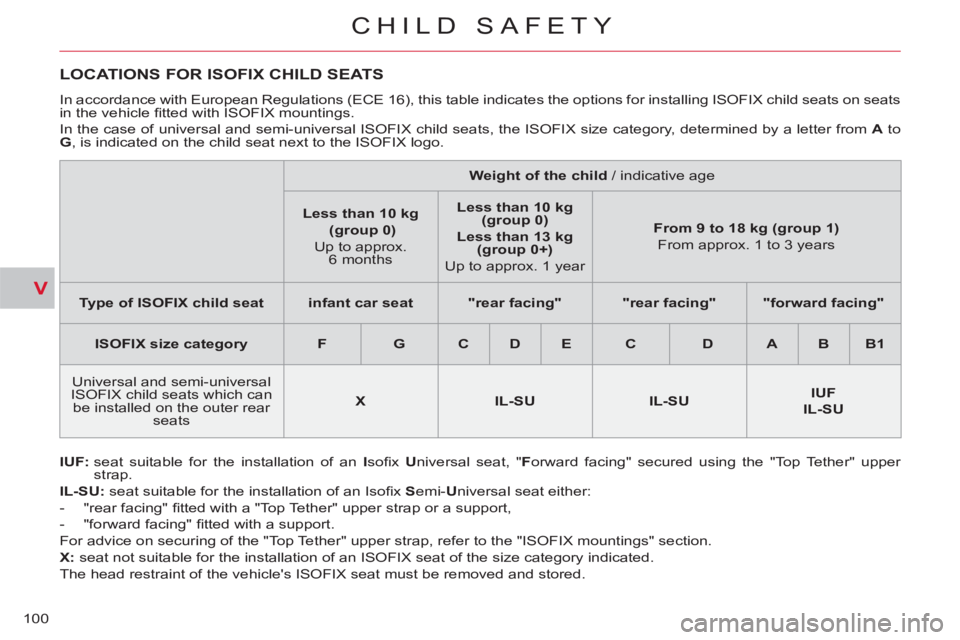
V
CHILD SAFETY
100
LOCATIONS FOR ISOFIX CHILD SEATS
IUF:
seat suitable for the installation of an I
sofi x U
niversal seat, " F
orward facing" secured using the "Top Tether" upper
strap.
IL-SU:
seat suitable for the installation of an Isofi x S
emi- U
niversal seat either:
- "rear facing" fi tted with a "Top Tether" upper strap or a support,
- "forward facing" fi tted with a support.
For advice on securing of the "Top Tether" upper strap, refer to the "ISOFIX mountings" section.
X:
seat not suitable for the installation of an ISOFIX seat of the size category indicated.
The head restraint of the vehicle's ISOFIX seat must be removed and stored. In accordance with European Regulations (ECE 16), this table indicates the options for installing ISOFIX child seats on seats
in the vehicle fi tted with ISOFIX mountings.
In the case of universal and semi-universal ISOFIX child seats, the ISOFIX size category, determined by a letter from A
to
G
, is indicated on the child seat next to the ISOFIX logo.
Weight of the child
/ indicative age
Less than 10 kg
(group 0)
Up to approx.
6 months
Less than 10 kg
(group 0)
Less than
13 kg
(group 0+)
Up to approx. 1 year
From 9 to 18 kg (group 1)
From approx. 1 to 3 years
Type of ISOFIX child seat
infant car seat
"rear facing"
"rear facing"
"forward facing"
ISOFIX size category
F
G
C
D
E
C
D
A
B
B1
Universal and semi-universal
ISOFIX child seats which can
be installed on the outer rear
seats
X
IL-SU
IL-SU
IUF
IL-SU
Page 103 of 244

V
!
CHILD SAFETY
101
ADVICE ON CHILD SEATS
Installing a booster seat
The chest part of the seat belt must
be positioned on the child's shoulder
without touching the neck.
Ensure that the lap part of the seat
belt passes correctly over the child's
thighs.
CITROËN recommends the use of
a booster seat which has a back, fi t-
ted with a seat belt guide at shoulder
level.
As a safety precaution, do not leave:
- one or more children alone and un-
supervised in a vehicle,
- a child or an animal in a vehicle
which is exposed to the sun, with
the windows closed,
- the keys within reach of children
inside the vehicle.
To prevent accidental opening of the
doors, use the "Child lock".
Take care not to open the rear win-
dows by more than one third.
To protect young children from the
rays of the sun, fi t side blinds on the
rear windows.
CHILD LOCK
�)
Lower the control A
to position 1
.
Child lock on
Child lock off
�)
Raise the control A
to position 2
.
Mechanical system to prevent open-
ing of the rear doors using their interior
controls.
The control is located on the edge of
each rear door. The incorrect installation of a child
seat in a vehicle compromises the
child's protection in the event of an ac-
cident.
Remember to fasten the seat belts or
the child seat harnesses keeping the
slack
in relation to the child's body to
a minimum
, even for short journeys.
For optimum installation of the "for-
ward facing" child seat, ensure that
the back of the child seat is in contact
with the back of the vehicle's seat and
that the head restraint does not cause
any discomfort.
If the head restraint has to be re-
moved, ensure that it is stored or at-
tached securely to prevent it from be-
ing thrown around the vehicle in the
event of sharp braking.
Children under the age of 10 must not
travel in the "forward facing" position
on the front passenger seat, unless
the rear seats are already occupied
by other children, cannot be used or
are absent.
Deactivate the passenger's airbag
when a "rear facing" child seat is in-
stalled on the front seat. Otherwise,
the child would risk being seriously
injured or killed if the airbag were to
infl ate.
Page 109 of 244
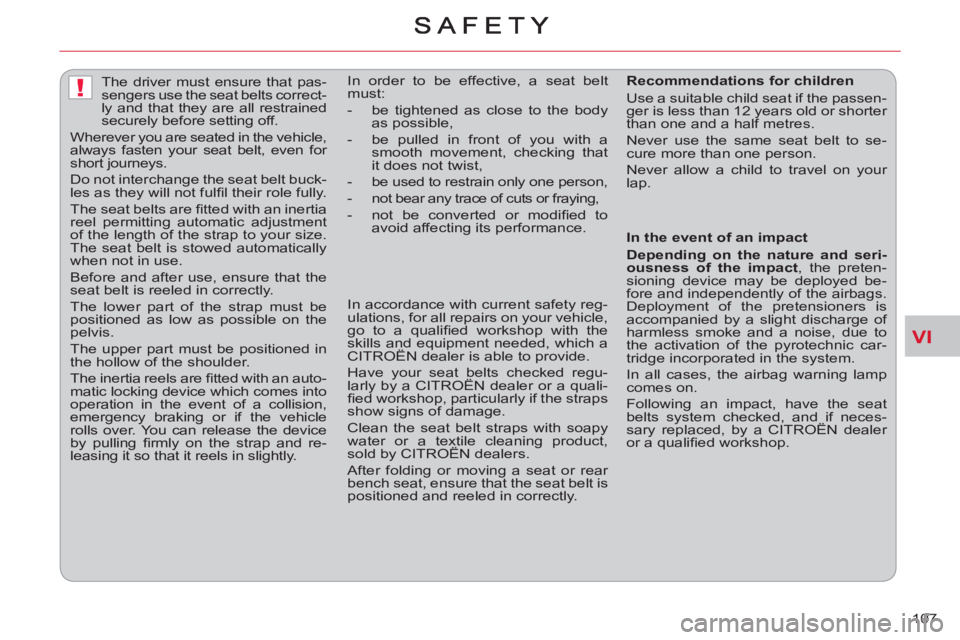
VI
!
107
The driver must ensure that pas-
sengers use the seat belts correct-
ly and that they are all restrained
securely before setting off.
Wherever you are seated in the vehicle,
always fasten your seat belt, even for
short journeys.
Do not interchange the seat belt buck-
les as they will not fulfi l their role fully.
The seat belts are fi tted with an inertia
reel permitting automatic adjustment
of the length of the strap to your size.
The seat belt is stowed automatically
when not in use.
Before and after use, ensure that the
seat belt is reeled in correctly.
The lower part of the strap must be
positioned as low as possible on the
pelvis.
The upper part must be positioned in
the hollow of the shoulder.
The inertia reels are fi tted with an auto-
matic locking device which comes into
operation in the event of a collision,
emergency braking or if the vehicle
rolls over. You can release the device
by pulling fi rmly on the strap and re-
leasing it so that it reels in slightly.
Recommendations for children
Use a suitable child seat if the passen-
ger is less than 12 years old or shorter
than one and a half metres.
Never use the same seat belt to se-
cure more than one person.
Never allow a child to travel on your
lap. In order to be effective, a seat belt
must:
- be tightened as close to the body
as possible,
- be pulled in front of you with a
smooth movement, checking that
it does not twist,
- be used to restrain only one person,
- not bear any trace of cuts or fraying,
- not be converted or modifi ed to
avoid affecting its performance.
In accordance with current safety reg-
ulations, for all repairs on your vehicle,
go to a qualifi ed workshop with the
skills and equipment needed, which a
CITROËN dealer is able to provide.
Have your seat belts checked regu-
larly by a CITROËN dealer or a quali-
fi ed workshop, particularly if the straps
show signs of damage.
Clean the seat belt straps with soapy
water or a textile cleaning product,
sold by CITROËN dealers.
After folding or moving a seat or rear
bench seat, ensure that the seat belt is
positioned and reeled in correctly.
In the event of an impact
Depending on the nature and seri-
ousness of the impact
, the preten-
sioning device may be deployed be-
fore and independently of the airbags.
Deployment of the pretensioners is
accompanied by a slight discharge of
harmless smoke and a noise, due to
the activation of the pyrotechnic car-
tridge incorporated in the system.
In all cases, the airbag warning lamp
comes on.
Following an impact, have the seat
belts system checked, and if neces-
sary replaced, by a CITROËN dealer
or a qualifi ed workshop.
Page 113 of 244

VI
!
111
Lateral airbags
Use only approved covers on the seats, compatible with the deployment the
lateral airbags. For information on the range of seat covers suitable for your
vehicle, you can contact a CITROËN dealer (see "Practical information - §
Accessories").
Do not fi x or attach anything to the seat backs (clothing...). This could cause
injury to the chest or arms if the lateral airbag is deployed.
Do not sit with the upper part of the body any nearer to the door than necessary.
For the airbags to be fully
effective, observe the
following safety rules:
Sit in a normal upright position.
Wear a correctly adjusted seat belt.
Do not leave anything between the
occupants and the airbags (a child,
pet, object...). This could hamper the
operation of the airbags or injure the
occupants.
After an accident or if the vehicle has
been stolen or broken into, have the
airbag systems checked.
All work on the airbag system must be
carried out by a CITROËN dealer or a
qualifi ed workshop.
Even if all of the precautions men-
tioned are observed, a risk of injury
or of minor burns to the head, chest
or arms when an airbag is deployed
cannot be ruled out. The bag infl ates
almost instantly (within a few millisec-
onds) then defl ates within the same
time discharging the hot gas via open-
ings provided for this purpose.
Curtain airbags
Do not fi x or attach anything to the roof. This could cause injury to the head if
the curtain airbag is deployed.
If fi tted on your vehicle, do not remove the grab handles installed on the roof,
they play a part in securing the curtain airbags.
Front airbags
Do not drive holding the steering wheel by its spokes or resting your hands on
the centre part of the wheel.
Passengers must not place their feet on the dashboard.
If possible, do not smoke as deployment of the airbags can cause burns or the
risk of injury from a cigarette or pipe.
Never remove or pierce the steering wheel or hit it violently.
Page 128 of 244

VIII
CHECKS
126
Bonnet stay
OPENING THE BONNET
To close
Lower the bonnet and release it at the
end of its travel. Check that the bonnet
is properly latched.
From outside:
move the safety catch
to the left then raise the bonnet. Secure the stay in its housing to hold
the bonnet open.
Before closing the bonnet, refi t the stay
in its clip.
This operation must only be carried out
when the vehicle is stationary.
When the engine is hot, handle the ex-
terior safety catch and the bonnet stay
with care (risk of burns).
RUNNING OUT OF FUEL
From inside:
pull the release lever A
,
on the left-hand side below the door, to-
wards you.
If you run out of fuel, fi ll the tank and
operate the starter until the engine
starts.
Several attempts may be needed before
the engine re-starts.
Page 134 of 244

IX
!
PRACTICAL INFORMATION
132
CHANGING A WHEEL
1.
Wheelbrace.
Used to remove the wheel trim and
the wheel fi xing bolts.
2.
Jack.
Used to raise the vehicle.
3.
Handle.
Used to extend the jack.
4.
Removable towing eye.
Refer to the "Towing" paragraph.
Other accessories
Wheel with trim
When removing the wheel
, remove
the trim fi rst using the handle 3
, pulling
at the notch.
When refi tting the wheel
, refi t the trim
starting by placing its notch F
(indicated
on the back of the trim) opposite the
valve G
and press on its outer edge
with the palm of your hand.
List of tools
When changing a wheel, ensure
that the four wheels are of identi-
cal specifi cation and brand. When storing, take care to secure
the tool bag D
fi rmly using the fi xing
band C
.
Access to the tools
The tools are stored in the storage
compartment in the boot right-hand trim.
To gain access to them:
�)
open the boot,
�)
turn button A
to the left,
�)
remove the cover B
,
�)
remove the fi xing band C
and take
out the tool bag D
containing the
tools,
�)
take the jack E
in your hand and re-
move it from its fi xing position.
Page 137 of 244
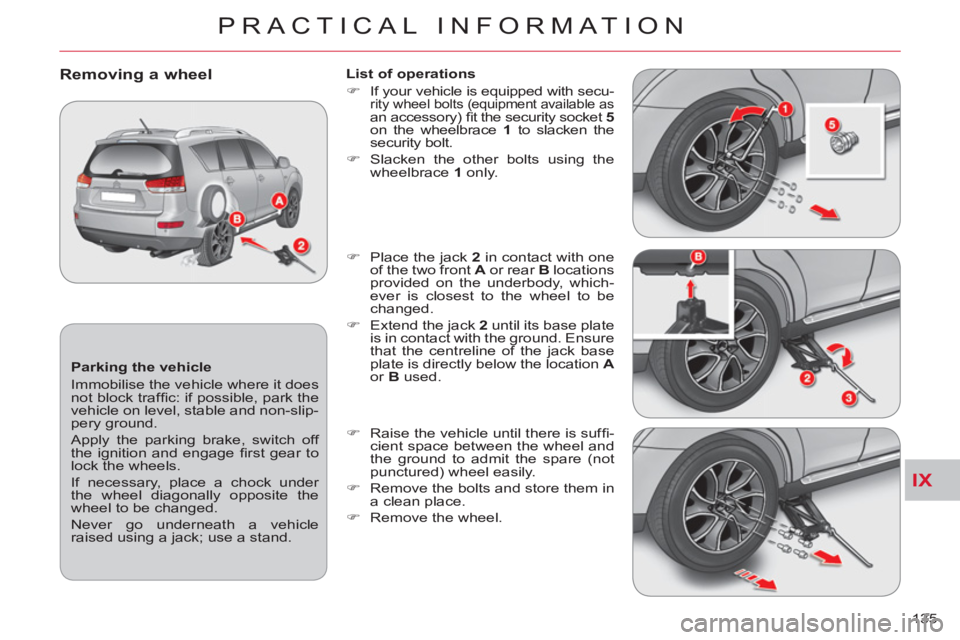
IX
PRACTICAL INFORMATION
135
Parking the vehicle
Immobilise the vehicle where it does
not block traffi c: if possible, park the
vehicle on level, stable and non-slip-
pery ground.
Apply the parking brake, switch off
the ignition and engage fi rst gear to
lock the wheels.
If necessary, place a chock under
the wheel diagonally opposite the
wheel to be changed.
Never go underneath a vehicle
raised using a jack; use a stand.
Removing a wheel
List of operations
�)
If your vehicle is equipped with secu-
rity wheel bolts (equipment available as an accessory) fi t the security socket 5
on the wheelbrace 1
to slacken the
security bolt.
�)
Slacken the other bolts using the
wheelbrace 1
only.
�)
Place the jack 2
in contact with one
of the two front A
or rear B
locations
provided on the underbody, which-
ever is closest to the wheel to be
changed.
�)
Extend the jack 2
until its base plate
is in contact with the ground. Ensure
that the centreline of the jack base
plate is directly below the location A
or B
used.
�)
Raise the vehicle until there is suffi -
cient space between the wheel and
the ground to admit the spare (not
punctured) wheel easily.
�)
Remove the bolts and store them in
a clean place.
�)
Remove the wheel.
Page 138 of 244
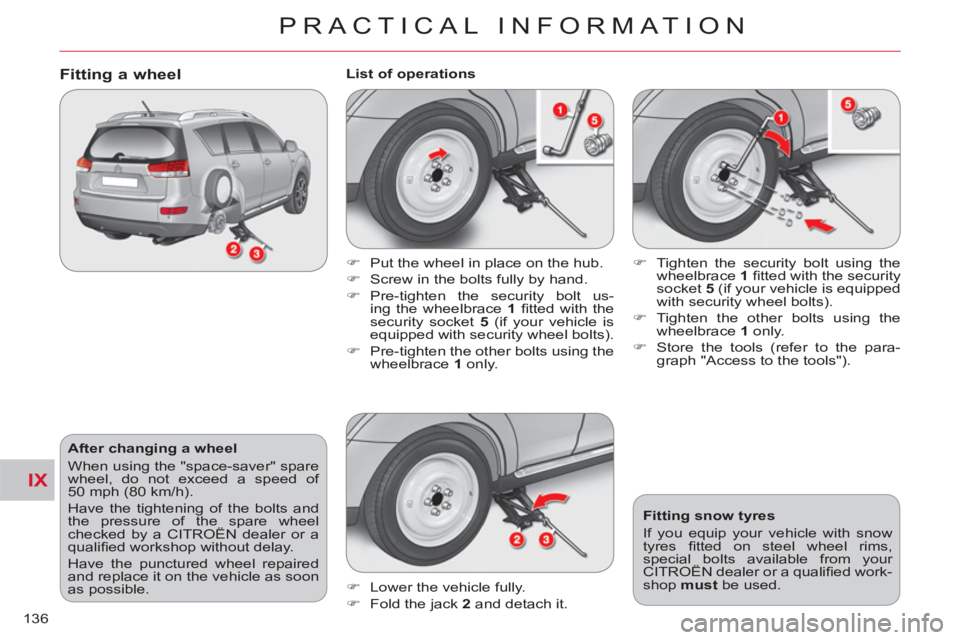
IX
PRACTICAL INFORMATION
136
After changing a wheel
When using the "space-saver" spare
wheel, do not exceed a speed of
50 mph (80 km/h).
Have the tightening of the bolts and
the pressure of the spare wheel
checked by a CITROËN dealer or a
qualifi ed workshop without delay.
Have the punctured wheel repaired
and replace it on the vehicle as soon
as possible.
Fitting a wheel
List of operations
�)
Lower the vehicle fully.
�)
Fold the jack 2
and detach it.
�)
Tighten the security bolt using the
wheelbrace 1
fi tted with the security
socket 5
(if your vehicle is equipped
with security wheel bolts).
�)
Tighten the other bolts using the
wheelbrace 1
only.
�)
Store the tools (refer to the para-
graph "Access to the tools").
Fitting snow tyres
If you equip your vehicle with snow
tyres fi tted on steel wheel rims,
special bolts available from your
CITROËN dealer or a qualifi ed work-
shop must
be used.
�)
Put the wheel in place on the hub.
�)
Screw in the bolts fully by hand.
�)
Pre-tighten the security bolt us-
ing the wheelbrace 1
fi tted with the
security socket 5 (if your vehicle is
equipped with security wheel bolts).
�)
Pre-tighten the other bolts using the
wheelbrace 1
only.